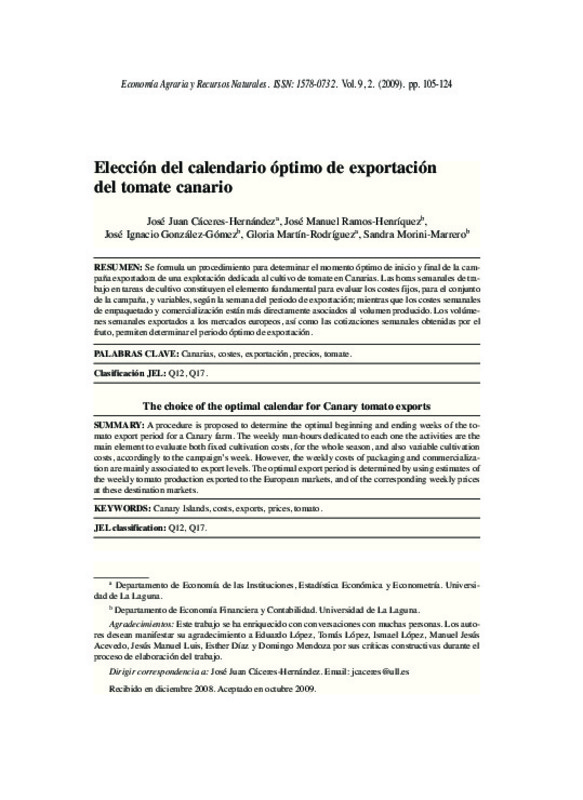JavaScript is disabled for your browser. Some features of this site may not work without it.
Buscar en RiuNet
Listar
Mi cuenta
Estadísticas
Ayuda RiuNet
Admin. UPV
The choice of the optimal calendar for Canary tomato exports
Mostrar el registro sencillo del ítem
Ficheros en el ítem
| dc.contributor.author | Cáceres-Hernández, José Juan
|
es_ES |
| dc.contributor.author | Ramos-Henríquez, José Manuel
|
es_ES |
| dc.contributor.author | González-Gómez, José Ignacio
|
es_ES |
| dc.contributor.author | Martín-Rodríguez, Gloria
|
es_ES |
| dc.contributor.author | Morini-Marrero, Sandra
|
es_ES |
| dc.coverage.spatial | east=-16.629130400000008; north=28.29156369999999; name=La Orotava, Santa Cruz de Tenerife, Espanya | es_ES |
| dc.date.accessioned | 2019-03-06T08:53:37Z | |
| dc.date.available | 2019-03-06T08:53:37Z | |
| dc.date.issued | 2011-10-14 | |
| dc.identifier.issn | 1578-0732 | |
| dc.identifier.uri | http://hdl.handle.net/10251/117713 | |
| dc.description.abstract | [EN] A procedure is proposed to determine the optimal beginning and ending weeks of the tomato export period for a Canary farm. The weekly man-hours dedicated to each one the activities are the main element to evaluate both fixed cultivation costs, for the whole season, and also variable cultivation costs, accordingly to the campaign’s week. However, the weekly costs of packaging and commercialization are mainly associated to export levels. The optimal export period is determined by using estimates of the weekly tomato production exported to the European markets, and of the corresponding weekly prices at these destination markets. | es_ES |
| dc.description.abstract | [ES] Se formula un procedimiento para determinar el momento óptimo de inicio y final de la campaña exportadora de una explotación dedicada al cultivo de tomate en Canarias. Las horas semanales de trabajo en tareas de cultivo constituyen el elemento fundamental para evaluar los costes fijos, para el conjunto de la campaña, y variables, según la semana del periodo de exportación; mientras que los costes semanales de empaquetado y comercialización están más directamente asociados al volumen producido. Los volúmenes semanales exportados a los mercados europeos, así como las cotizaciones semanales obtenidas por el fruto, permiten determinar el periodo óptimo de exportación. | es_ES |
| dc.language | Español | es_ES |
| dc.publisher | Universitat Politècnica de València | |
| dc.relation.ispartof | Economía Agraria y Recursos Naturales - Agricultural and Resource Economics | |
| dc.rights | Reserva de todos los derechos | es_ES |
| dc.subject | Canarias | es_ES |
| dc.subject | Costes | es_ES |
| dc.subject | Exportación | es_ES |
| dc.subject | Precios | es_ES |
| dc.subject | Tomate | es_ES |
| dc.subject | Canary Islands | es_ES |
| dc.subject | Costs | es_ES |
| dc.subject | Exports | es_ES |
| dc.subject | Prices | es_ES |
| dc.subject | Tomato | es_ES |
| dc.title | The choice of the optimal calendar for Canary tomato exports | es_ES |
| dc.title.alternative | Elección del calendario óptimo de exportación del tomate canario | es_ES |
| dc.type | Artículo | es_ES |
| dc.date.updated | 2019-03-05T13:31:44Z | |
| dc.identifier.doi | 10.7201/earn.2009.02.05 | |
| dc.rights.accessRights | Abierto | es_ES |
| dc.description.bibliographicCitation | Cáceres-Hernández, JJ.; Ramos-Henríquez, JM.; González-Gómez, JI.; Martín-Rodríguez, G.; Morini-Marrero, S. (2011). The choice of the optimal calendar for Canary tomato exports. Economía Agraria y Recursos Naturales - Agricultural and Resource Economics. 9(2):105-124. https://doi.org/10.7201/earn.2009.02.05 | es_ES |
| dc.description.accrualMethod | SWORD | es_ES |
| dc.relation.publisherversion | https://doi.org/10.7201/earn.2009.02.05 | es_ES |
| dc.description.upvformatpinicio | 105 | es_ES |
| dc.description.upvformatpfin | 124 | es_ES |
| dc.type.version | info:eu-repo/semantics/publishedVersion | es_ES |
| dc.description.volume | 9 | |
| dc.description.issue | 2 | |
| dc.identifier.eissn | 2174-7350 |








